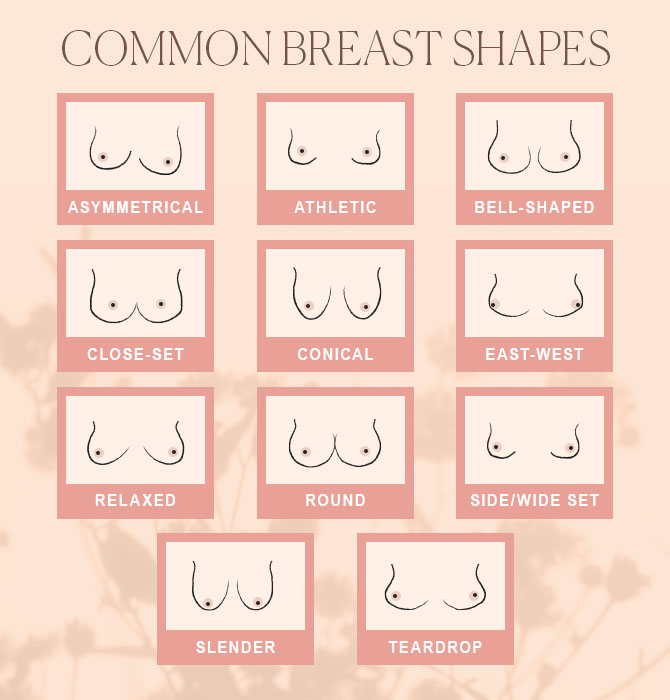The most common breast shapes are as follows :
- Asymmetrical : This is when women's breasts are of two different sizes, which is very common.
- Athletic : Athletic breasts are wider with more muscle and less breast tissue.
- Bell Shape : Bell-shaped breasts are narrow on top and rounder on the bottom like a bell.
- Close Set : These breasts have a small gap between them and are placed close to the center of the chest.
- Conical : Shaped like cones instead of being round, this shape is common for smaller breasts.
- East West : This is the shape when your nipples point outward, away from the center of your body.
- Relaxed : This shape is for breasts with looser breast tissue and nipples that point downward.
- Round : Round breasts have the same amount of fullness at the top and the bottom.
- Side set : Side-set breasts are spaced far apart with more space between them.
- Slender : This shape is when your breasts are narrow and long and the nipples point downward.
- Teardrop : The teardrop shape is round where the bottom is a little fuller than the top.
Breasts Size
Breasts can range in size from small to large, depending upon the amount of fat in your breasts — the more fat, the bigger the bust size. It is common and perfectly normal for one breast to be larger than the other, a condition called asymmetry. However, size has nothing to do with the ability to breastfeed and does not affect breast sensitivity or sexual arousal.
When talking about breast size, the reference point is bra size, which is usually based on two measurements :
Band size – the inches around the chest directly beneath the breasts plus 4 inches if the number is even or 5 inches if the number is odd. For example, if you measure 30 inches beneath the breast, your band size would be 30 + 4 or 34 inches. If you measure 31 inches beneath the breast, your band size would be 31 + 5 or 36 inches.
Cup size – the measurement of the fullest part of the bust rounded to the nearest inch.
Bra size results from subtracting your band size from your bust measurement. Each inch of difference is one cup size described as a letter starting with A. For example, if your bust measures 34 inches and your band size is 33, the difference is one inch or an A cup. Less than one inch is an AA cup while a 2-inch difference represents a B cup, a 3-inch difference is a C cup, and a 4-inch difference is a D cup. After that, differences in inches are measured as DD/E, DDD/F and above.
What can affect breast size and shape?
You may also notice that your breasts are a different size or shape than they were when you were younger. Changes to your breasts are a normal part of aging. Changes in firmness or size are very common too.
These are the major factors:
- Your genes : According to research, your genes play a key role in determining breast size. In fact, a 2012 study of 16,175 women identified seven genetic markers linked with a woman's bra size.
-Your weight : Because size is linked to the amount of fat in the breast, you may see a change in cup size if you gain or lose weight.
- Exercise : While not changing your breast size, doing exercises to build up the muscles behind your breast tissue will make your breasts seem slightly perkier and appear a little bigger.
- Hormonal changes : As you get close to your period, your body produces progesterone, which causes swelling (and some soreness) in the breasts. Similarly, the estrogen and progesterone in hormonal birth control can increase your breast size somewhat.
- Pregnancy : During pregnancy, breasts can grow several cup sizes due to increased production of progesterone.
- Age : Many breast changes are linked to the years around menopause when levels of estrogen drop dramatically. As a result, breast tissue becomes less firm, loses its fullness and becomes fattier, which leads to sagging and can produce downward pointing nipples. Other factors leading to breast droop are weight gain, smoking and heredity.












